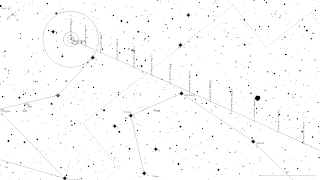Thursday, November 07, 2013
Comet C/2012 S1 ISON is not dead yet, 8-15 November 2013
The rumours of ISON's demise are greatly exaggerated. The comet continues to slowly brighten, and its gas production rate has been reported to be increasing substantially. It has been imaged with DSLR cameras in the UK.
Comet C/2012 S1 ISON continues to be reported to be (just) visible in 10x50 binoculars, and has been picked up by Australian observers. Currently still somewhere around magnitude 8, it is visible in small scopes and strong binoculars. In binoculars it should look like a faint, fuzzy dot. However, its fuzzy, diffuse nature, its closeness to the horizon (between 7 -12 degrees depending on where you are, except Darwin and Far North Queensland, where it is more like 20 degrees above the horizon see here for charts illustrating the difference at different sites) means that it can be difficult to spot visually in smaller scopes.
It looks like by the 8th it will still be under magnitude 7, and still a bit of a struggle to see in binoculars.
The comet is to the right of Mars, making finding it relatively easy. The best time to look for it is when it is highest in the sky and the sky is darkest. However, especially in the Southern States, because it never gets very high, the best time to look is astronomical twilight. Astronomical twilight is an hour and a half before local sunrise.
On November 8 the comet is in the
constellation of Virgo, and is between Earth's and Venus's orbits (see image
above). At this time comet
ISON is just under a hand span above the horizon as seen from the
latitude of
Melbourne, just over a hand span as seen from the latitude of Sydney,
nearly
two hand spans as seen from the latitude of Brisbane and almost 4 hand
spans as
seen from the latitude of Darwin. A hand-span is the distance across
your knuckles when your hand is outstreached at the end of your arm as
if making a "stop" sign.
On the 8th the comet is close to the bright star Zanijava, Beta (β) Virginis. Sweeping diagonally east about a
handspan is the next brightest star Zaniah, eta (η) Virginis. From the 8th the
comet heads towards Zaniah, and is closest on the 11th. Between the 8th and the
11th sweeping between and a little above these stars should reveal the comet.
Sweeping diagonally down yet again from
Zaniah is the bright star Porrima, gamma (γ) Virginis. Between the 11th and the
14th the comet is running several finger widths above an imaginary line joining
these stars. On the 14th comet ISON is 4 finger widths above Porrima, and
should be (just) visible to the unaided eye and easily visible in binoculars.
However, the comet is also sinking towards
the horizon, so you will have to wait deeper in the twilight for the comet to
get reasonably high above the horizon, as the sky brightens the comet will be
more difficult to see, offsetting its own rise in brightness.
A printable PDF map is here.
Labels: binoculars, C/2012 S1 ISON, telescope







 Click to read about or order
Click to read about or order Click to read about or order
Click to read about or order Click to read about or order
Click to read about or order Click to read about or order
Click to read about or order




